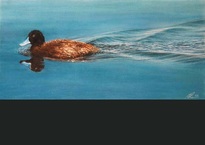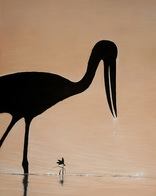The Art of Andy Reimanis
Fernvale
Fernvale
|
Grey Goshawks over the Border Ranges
$5500 One of nineteen birds of prey (diurnal) species recorded in Australia's Green Cauldron, the Grey Goshawk prefers to live in heavily timbered country, including rainforests. This pair was seen near the Bar Mt lookout. Their relatively short wings allow greater manoeuvrability whilst hunting prey near ground level. Goshawks pair for life and maintain home territories which they often survey in the early morning. The Border Ranges National Park is home to several pairs. < back |
|
In Full Voice (Albert's Lyrebird)
Sold The Albert's Lyrebird is found only in the moist forests of the Green Cauldron region. The related Superb Lyrebird is more widely distributed along the east coast of Australia. During winter, the 'Alberts' sings and displays on a 'stage' of tangled vines to attract a mate. It is an accomplished mimic with natural bush sounds as well man-made sounds superbly vocalised. This painting was inspired by brief glimpses (and sounds) of this bird in Lamington National Park, the film 'Rainforest Secrets' by cinematographer David Warth, and the work of wildlife photographer Glen Threlfo. < back |
|
Beechmont Plateau
Commissioned Settled by timber getters and dairy farmers well over a century ago, this region has a fascinating social and natural history. The plateau (over 800 metres above sea level) was once covered by tall forests. Now, the rolling pastures are usually lush and green with only scattered timber remaining. Yet the Wedge-tailed Eagle still soars over the countryside and the adjacent Lamington National Park remains as one of the most significant rainforest refuges in Australia's Green Cauldron. < back |
|
From Bellbird Lookout
$1500 The view to the north from Bellbird Lookout is spectacular and very inspirational for all who visit Binna Burra Mountain Lodge. In the foreground is Egg Rock, a remnant plug of rhyolite (a type of granite), part of the formation of the Tweed shield volcano some 20 million years ago. The Numinbah Valley is a mosaic of farmland and forest with the mighty Hinze Dam providing water for the Gold Coast in the far distance. New growth on the Tallowwood trees offers a colourful foreground. With a new vegetation management plan in place at Binna Burra, unfortunately this view will eventually disappear. < back |
|
Black Swans at Dawn
Sold One of the many picturesque waterways in the Tweed Shire is the Clarrie Hall Dam, south of Mt Warning. Usually the mountain is in full view along with the surrounding forests and pastures. But early one winters morning, the overnight mists remained low over the water to form a romantic atmospheric effect. When two pairs of swans glided past each other, the inspiration for a painting was complete. Soft pastels were the preferred medium since they have profound blending capability. < back |
|
Black-necked Stork Study Sold The Black-necked Stork is commonly, but mistakenly called the ‘jabiru’ which is a native Brazilian word for a South American stork. It is not a traditional Australian Aboriginal word although has now been adopted. It hunts for fish and frogs in wetlands by stalking and probing in shallow water, then unleashing a spearing jab of its powerful bill. The females have yellow eyes, the males black. There appear to be only a few nesting pairs in the Green Cauldron region with their conservation status reliant on the preservation of wetlands. < back |
|
Blue-billed Duck Study
Sold Having seen this splendid waterfowl on numeous occasions during my childhood on the shores of Lake Wendouree, Ballarat, it was exciting to catch sight of it in the caldera region where it is rarely seen. The Blue-billed duck generally 'duck-dives' for its food and is a strong swimmer with its feet positioned near the rear of its body. <back |
|
Mt Doughboy from Nightcap
Sold From the Nightcap Saddle (a vantage point on the southern rim of the Tweed erosion caldera) the rhyolite outcrop known as Mt Doughboy and the mighty Wollumbin Mt Warning can be seen. Along with Egg Rock in the Numinbah Valley, each was created when lava flows formed the Tweed shield volcano some 23 million years ago. Erosion has taken these landmarks down to half their original height and formed the caldera. Unfortunately this lookout is accessible only through private property, or a long trek along the Nightcap Track from the south. < back |
|
Great Egrets over Clarrie
Sold In a departure from my usual painting style, I have attempted to convey the essence of the colours of the Tweed in a more impressionistic way. The shire is surrounded by mountain ranges cloaked in a variety of forest types with a rich tapestry of muted colours fading off into the distance. I am especially drawn to the region's waterways which reflect the splendid patterns, colours and movement of the surrounding landscape. A pair of Great Egrets take flight from a wetland which not only supports native species of flora and fauna but also harbours exotic water weeds. < back |
|
Koala Study
Sold Koalas are generally nocturnal and spend most of the day sleeping in order to conserve the very little energy they derive from a diet of eucalyptus leaves. Favoured local food trees include Tallowwood, Blackbutt, Flooded Gum and Brush Box. Landcare groups in the Tweed region are planting many thousands of these species in an attempt to stabilise declining Koala populations. As an adaption to living in trees (arboreal), Koalas have two 'thumbs' on each hand. They are becoming very rare in Australia's Green Cauldron mainly due to habitat clearing. < back |
|
At last light
Sold As viewed from near the Murwillumbah Visitors Centre, on the banks of the Tweed River, the distant Mt Warning glows strongly with light from the setting sun. Similarly, the forest covered granite slopes of Mt Nullum see the last rays of the sun for the day. I chose to keep the colours of the clouds relatively subdued in order to maintain the focus of the intense light on the mountains. Likewise, the Tweed River and foreground trees are well and truly 'plunged in darkness'. < back |
|
Lorikeet Frenzy
Sold Rainbow Lorikeets (and Scaly-breasted Lorikeets) feed mostly on the nectar and pollen of flowering trees. Their brush-tipped tongues are highly specialised for blossom feeding, although they do occasionally take insects and grubs (and fruit) found around flowering foliage. Whilst it is a pleasure to attract native birds into our gardens, feeding them artificial food can be detrimental to their health as the correct balance of nutrients is often lacking. This can also lead to laziness and aggression. < back |
|
Remnant Volcano
Sold From an aerial perspective, the mighty Wollumbin Mt Warning appears as a weather beaten, fragmented landscape. After some 20 million years of erosion by the forces of wind and rain, the summit is now half its former height of two kilometres above sea level, revealing its original 'deep plumbing'. The concentric shaped deposition of lava from the central vent is apparent with the late afternoon light illuminating the western escarpments and casting deep shadows in the eroded gullies. A Wedge-tailed Eagle soars in a thermal above the forests of Australia's Green Cauldron. < back |
|
Leaf be Me
$850 Superbly camouflaged among dead leaves on the rainforest floor, a Giant Barred Frog awaits nightfall. This species is one of the five ‘Barred frogs’ (genus Mixophyes) found in moist, forested locations along eastern Australia. All are relatively large (average 10 cm), with the largest tadpoles of any Australian frog (12.5 cm). Due to their size and terrestrial habits, barred frogs are often mistaken for Cane Toads. By maintaining vegetation and deep leaf-litter around streams, and minimising run-off of agricultural chemicals in catchments, land managers can help conserve these interesting frogs. < back |
|
Osprey Catch
Commissioned The highly adapted Eastern Osprey feeds almost entirely on fish. It plunges into the water with outstretched legs, capturing its target with strong feet and long talons. The coastal regions of the Tweed and Australia's Green Cauldron are fortunate to have many breeding pairs thanks to the construction of special nesting towers and public awareness of the dangers of discarding recreational fishing tackle. < back |
|
Regent Bowerbird Study
Sold Regent Bowerbirds are usually found in forests, particularly rainforest and densely treed gullies throughout Australia’s Green Cauldron. Although mainly sedentary, during the winter months they congregate in large groups (including the brown females and immature birds), and move from higher altitude forests towards the coast. Like their equally impressive cousins, the Satin Bowerbirds, the males build display and courtship bowers to (hopefully) impress females. Green and brown objects are collected rather than blue coloured items. < back |
|
Stalking Stork Sold The Black-necked Stork is commonly, but mistakenly, called the ‘Jabiru’, a native Brazilian word for a South American stork species. They hunt for fish and frogs in wetlands by stalking and probing in shallow water, then unleashing a spearing jab with its powerful bill. Australia's Green Cauldron is home to only several breeding pairs since they need to range far and wide for optimum feeding and nesting requirements. < back |
|
Young Tawny Frogmouths
Sold Tawny Frogmouths are more closely related to Kookaburras than owls or nightjars, and generally catch prey in a similar way ie. take insects, frogs, small lizards and mice from the ground rather than on the wing.. The Frogmouth’s camouflage is one of nature’s wonders, but if approached too close, the nestlings will give a loud hiss with a threatening wide open beak. Although the Tawnys are relatively common, the closely related Marbled Frogmouths are very rare and localised within the remnant rainforests and wet eucalypt forests of Australia's Green Cauldron. < back |
|
Young Wedge-tailed Eagle
Sold The Wedge-tailed Eagle is Australia’s largest bird of prey with an adult’s wingspan being well over two metres. This juvenile bird is distinguished from the adult by its reddish-brown nape feathers and pink gape. The eyes indicate a determined yet inquisitive attitude. Eagles have about three times the acuteness of vision than humans. There are only several breeding pairs in Australia's Green Cauldron since they need to range far and wide for optimum feeding and breeding requirements. By retaining tall trees as possible nesting sites, and providing significant buffer zones, landowners can ensure that these birds have a future in the region. < back |
|
Skimming Duck
Sold Being a very dry continent, Australia has relatively few waterfowl species. The White-eyed Duck is our only representative of the 'pochard' diving duck family. The characteristic of Australia's waterfowl is their mobility - an adaptation to our sparse, often irregular rainfall. This species flies swiftly and has its feet set well back for underwater swimming, but ungainly walking. 'Artistic licence' has been used in the portrayal of its plumage in this painting. < back |
|
Andy Reimanis
Artist-in-residence, Caldera Wildscapes Gallery My artwork attempts to reflect the determination of flora and fauna species to survive adverse changes to their environment. I gain inspiration from their tenacity and adaptability. My passion is to attempt a faithful depiction of the beauty and fascination of the natural world through careful observation of the ever present complexity of colours, shapes and textures. The Tweed region is a veritable treasure trove of subject matter for artists inspired by the natural landscape and the biodiversity therein. < back |





















